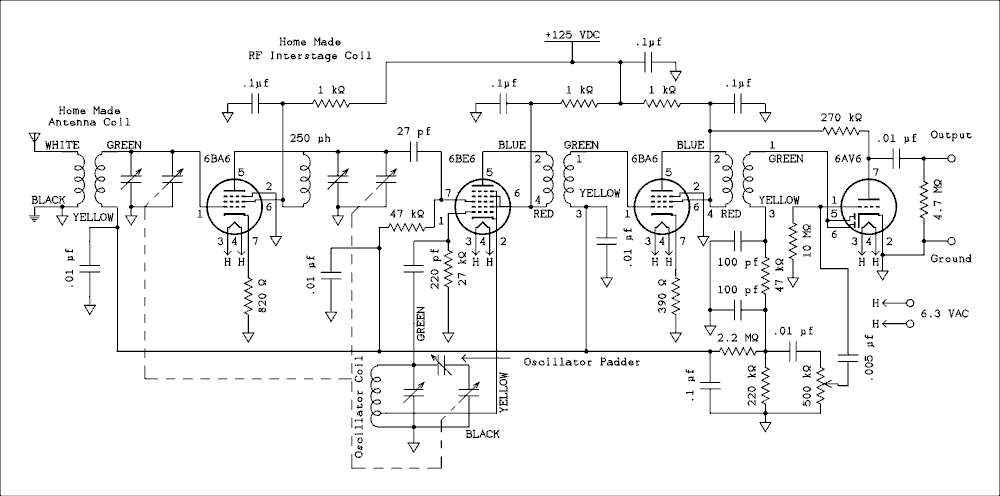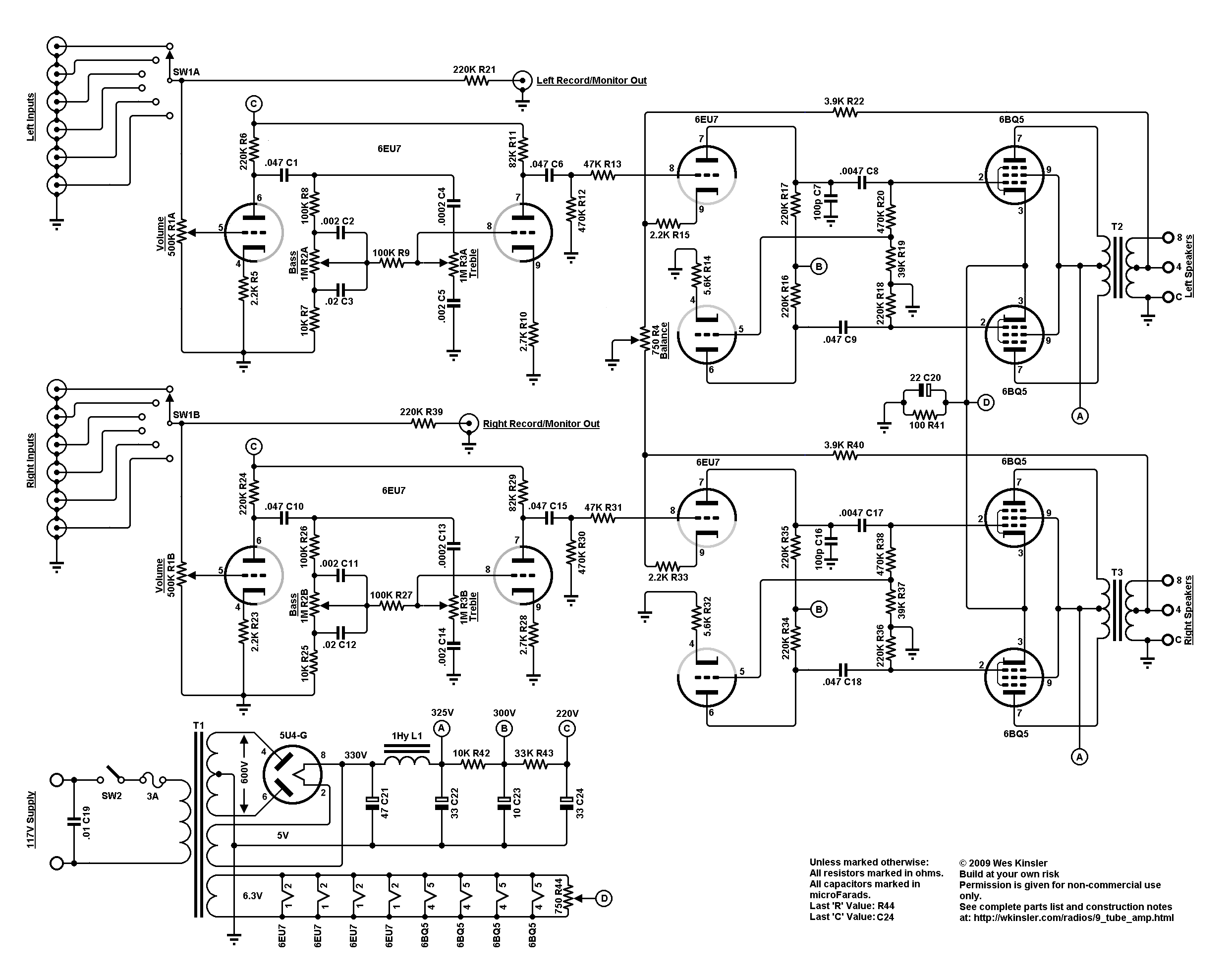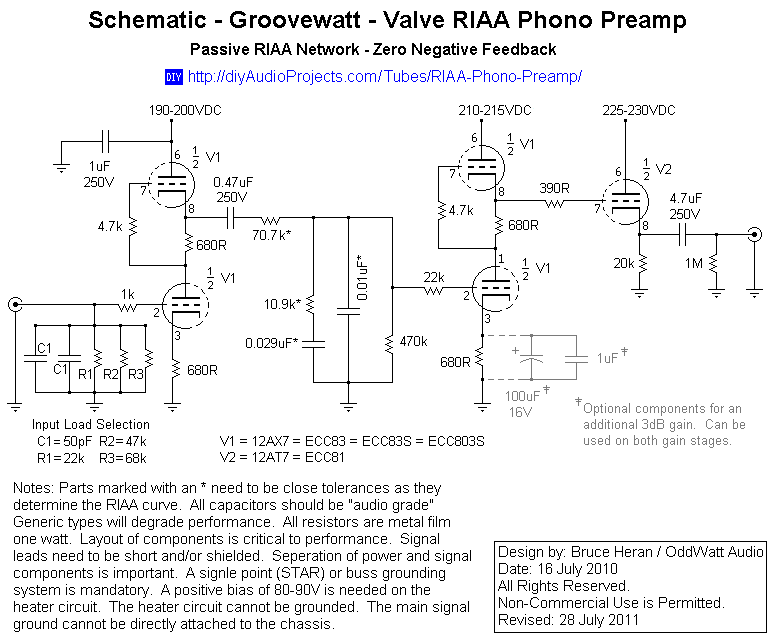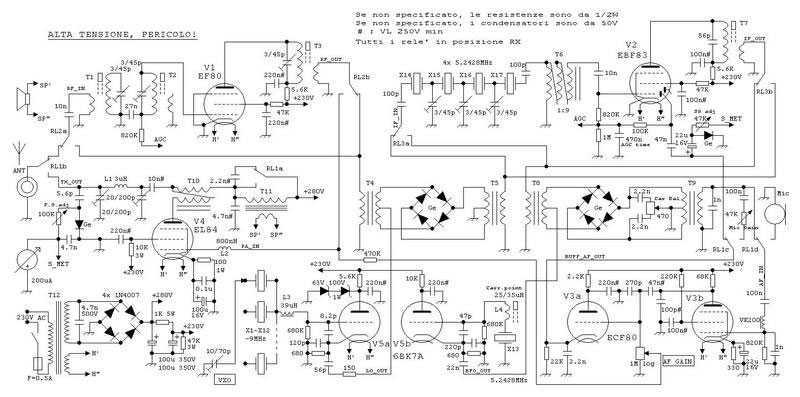
4 Tube Superhet

The theory of operation has been previously discussed in the Simple Superhet or the All American Five. Constructing this radio is relatively straightforward, especially if the circuits have been followed in the order presented. The variable capacitor used is one that was available, but a similar model can be found in the Antique Electronics Supply catalog and on their website. It features three sections with capacitance values ranging from 30 to 470 picofarads per section. While this capacitor may not be optimal for the AM band, it is currently the only option available. Ideally, the variable capacitor would have one section with a smaller capacitance than the other two. If a suitable capacitor is available, it should be utilized. Some variable capacitors include small adjustable screws on the side for each section. Individuals unfamiliar with electronics may mistakenly tighten these screws, which are actually small trimmer capacitors. Tightening the screws compresses the metal plates, which are separated by insulating mica, thereby increasing the capacitance. These are represented in the schematic as variable capacitors in parallel with the main tuning capacitor sections. If a tuning capacitor with one small section and three trimmer capacitors is available, the subsequent sections regarding the padder capacitor can be skipped. For those with a similar tuning capacitor to the one described, which has only one built-in trimmer on the center section, the front section should be designated as the oscillator tuner. The screw for the trimmer should be loosened to its maximum expansion. If additional trimmers are needed, a value between 7 to 45 or 10 to 50 picofarads can be used. The schematic indicates that the trimmer is placed across the coil in the oscillator section, necessitating the use of an external trimmer rated at 10 to 100 picofarads. The antenna coil is the same as that used in all radio circuits. An issue arose with maintaining oscillation using the RF interstage coil from the TRF radio, leading to the decision to simplify to a single coil consisting of 66 turns of number 26 (green) wire wound on a 2-inch mailing tube. The oscillator coil has been modified to include a trimmer and padder for alignment, reducing the total turns to 40 from the original 45. This coil can either be constructed anew or adjusted from an existing one. Proper alignment of the radio requires a frequency counter, which has become more affordable and is recommended for those interested in radio experimentation. Initially, local stations should be audible even before alignment. To align the radio, the RF amplifier (6BA6) should be removed from its socket. If a signal generator is available, its output should be connected to pin 1 of the 6BE6 to disable the local oscillator. The frequency generator should be set to 455.0 kHz. In the absence of a signal generator, the tuning capacitor should be set to maximum (fully meshed), and the frequency counter connected to pin 5 of the 6BE6 through a DC blocking capacitor (0.001 microfarad). With the power off, a wire should be temporarily soldered across the padder capacitor to short it, and an 820 pF capacitor should be connected in parallel with the oscillator coil. After powering on the circuit, the tuning capacitor should be adjusted until the frequency counter reads 455.0 kHz. If using a signal generator, its output level should be adjusted to provide approximately 5 volts on the voltmeter. A plastic alignment tool is then used to adjust the slugs or screws in the two IF transformers for maximum voltmeter readings. The power should be turned off, and the short across the padder and the 820 pF capacitor from the coil should be removed. The frequency counter can then be reconnected to pin 5 of the 6BE6.
The construction of this radio involves several critical components and steps to ensure proper functionality and alignment. The variable capacitor serves as the heart of the tuning mechanism, enabling the selection of desired frequencies. The choice of a three-section capacitor allows for fine-tuning across the AM band, although the ideal configuration would include a smaller section for optimal performance. The use of trimmer capacitors allows for precise adjustments, which is essential for achieving the best reception quality.
The antenna coil design is key to the radio's ability to pick up signals effectively. The simplification to a single coil design with 66 turns is a practical approach that balances performance with ease of construction. The oscillator coil's adjustment to 40 turns, along with the incorporation of trimmer and padder capacitors, highlights the importance of alignment in radio circuits. The alignment procedure, which involves the use of a frequency counter and signal generator, is a critical step that ensures the radio operates at the correct frequency, maximizing its ability to receive signals.
In summary, the detailed steps and components outlined in this construction guide provide a comprehensive framework for building and aligning a radio receiver. By following these guidelines, one can achieve a functional and well-tuned radio capable of receiving AM broadcasts effectively.The theory of operation has already been covered either in the Simple Superhet or the All American Five. Building this radio is really not hard especially if you have been working along through the circuits in the order I have presented them.
The variable capacitor is one I happened to have on hand but there is one like it listed in the Antique El ectronics Supply catalog and on their web site. It is a 3 section 30 to 470 picofarad per section. This is not the best for the AM band but it`s all I have. The ideal capacitor would have one section smaller than the other two. If you have or can get one by all means get it and use it. Some variable capacitors have what look like screws on the side; one for each section. People who are not knowledgeable about electronics will sometimes tighten up these screws because they in fact are loose. These screws are small adjustable capacitors. As the screws are tightened the metal plates, which are separated by the insulating mica, are pressed closer together thus increasing the capacitance.
These are shown in the schematic diagram as variable capacitors in parallel with the sections of the main tuning capacitor. If you have one of those tuning capacitors with one small section and it has three trimmer capacitors on it you can skip the rest of this section and the entire section on the padder capacitor.
If you are still reading you have a tuning capacitor like the one I have. Mine has only one trimmer built in and it is on the center section. If yours has three trimmers you will need one less external trimmer than I did. Use the front section (closest to where the shaft comes out) as the oscillator tuner. Loosen this screw until the trimmer has expanded as much as it will. If you need to add one or two trimmers use 7 to 45 or 10 to 50 picofarad or something reasonably close. On the schematic you will notice that in the oscillator the trimmer is across the coil. You will have to use an external (to the tuning capacitor) trimmer. Use a 10 to 100 picofarad unit here. The antenna coil is the same one used in all the radio circuits. For some reason I couldn`t keep the circuit from oscillating using the RF interstage coil we used in the TRF radio.
I have reduced it to just one coil, 66 turns of the number 26 (green) wire on a 2 inch mailing tube. The oscillator coil is a bit different because of the trimmer and padder used for alignment. It is now 40 turns total instead of the original 45. You can wind a new one from scratch or take turns off of the one you already made. To properly align this radio you really need a frequency counter. There not that expensive any more so if you don`t have one and you want to play with radios you really ought to get one. When you first turn on the power you should be able to hear your local stations even before alignment.
Remove the RF amplifier (6BA6 from its socket. If you have a signal generator connect its output to pin 1 of the 6BE6, this will "kill" the local oscillator. Use your frequency counter to set the generator to 455. 0 kc. If you don`t have a signal generator set the tuning capacitor to maximum (fully meshed) and connect your frequency counter to pin 5 of the 6BE6 through a DC blocking capacitor (.
001 microfarad). Be sure the power is turned off. Temporarily solder a wire across the padder capacitor to short it out. Temporarily solder a 820 pf capacitor in parallel with the oscillator coil. Turn the power back on. Adjust the tuning capacitor until the frequency counter reads 455. 0 kc. If you have a signal generator, and are using it, adjust its output level until you get about 5 volts on the voltmeter. Use a plastic alignment tool to adjust the slugs or screws in the two IF transformers for a maximum reading on the voltmeter.
Turn off the power. Unsolder the wire from the padder and the 820 pf capacitor from the coil. Reconnect the frequency counter to pin 5 of the 6BE6. If you used a 🔗 External reference
The construction of this radio involves several critical components and steps to ensure proper functionality and alignment. The variable capacitor serves as the heart of the tuning mechanism, enabling the selection of desired frequencies. The choice of a three-section capacitor allows for fine-tuning across the AM band, although the ideal configuration would include a smaller section for optimal performance. The use of trimmer capacitors allows for precise adjustments, which is essential for achieving the best reception quality.
The antenna coil design is key to the radio's ability to pick up signals effectively. The simplification to a single coil design with 66 turns is a practical approach that balances performance with ease of construction. The oscillator coil's adjustment to 40 turns, along with the incorporation of trimmer and padder capacitors, highlights the importance of alignment in radio circuits. The alignment procedure, which involves the use of a frequency counter and signal generator, is a critical step that ensures the radio operates at the correct frequency, maximizing its ability to receive signals.
In summary, the detailed steps and components outlined in this construction guide provide a comprehensive framework for building and aligning a radio receiver. By following these guidelines, one can achieve a functional and well-tuned radio capable of receiving AM broadcasts effectively.The theory of operation has already been covered either in the Simple Superhet or the All American Five. Building this radio is really not hard especially if you have been working along through the circuits in the order I have presented them.
The variable capacitor is one I happened to have on hand but there is one like it listed in the Antique El ectronics Supply catalog and on their web site. It is a 3 section 30 to 470 picofarad per section. This is not the best for the AM band but it`s all I have. The ideal capacitor would have one section smaller than the other two. If you have or can get one by all means get it and use it. Some variable capacitors have what look like screws on the side; one for each section. People who are not knowledgeable about electronics will sometimes tighten up these screws because they in fact are loose. These screws are small adjustable capacitors. As the screws are tightened the metal plates, which are separated by the insulating mica, are pressed closer together thus increasing the capacitance.
These are shown in the schematic diagram as variable capacitors in parallel with the sections of the main tuning capacitor. If you have one of those tuning capacitors with one small section and it has three trimmer capacitors on it you can skip the rest of this section and the entire section on the padder capacitor.
If you are still reading you have a tuning capacitor like the one I have. Mine has only one trimmer built in and it is on the center section. If yours has three trimmers you will need one less external trimmer than I did. Use the front section (closest to where the shaft comes out) as the oscillator tuner. Loosen this screw until the trimmer has expanded as much as it will. If you need to add one or two trimmers use 7 to 45 or 10 to 50 picofarad or something reasonably close. On the schematic you will notice that in the oscillator the trimmer is across the coil. You will have to use an external (to the tuning capacitor) trimmer. Use a 10 to 100 picofarad unit here. The antenna coil is the same one used in all the radio circuits. For some reason I couldn`t keep the circuit from oscillating using the RF interstage coil we used in the TRF radio.
I have reduced it to just one coil, 66 turns of the number 26 (green) wire on a 2 inch mailing tube. The oscillator coil is a bit different because of the trimmer and padder used for alignment. It is now 40 turns total instead of the original 45. You can wind a new one from scratch or take turns off of the one you already made. To properly align this radio you really need a frequency counter. There not that expensive any more so if you don`t have one and you want to play with radios you really ought to get one. When you first turn on the power you should be able to hear your local stations even before alignment.
Remove the RF amplifier (6BA6 from its socket. If you have a signal generator connect its output to pin 1 of the 6BE6, this will "kill" the local oscillator. Use your frequency counter to set the generator to 455. 0 kc. If you don`t have a signal generator set the tuning capacitor to maximum (fully meshed) and connect your frequency counter to pin 5 of the 6BE6 through a DC blocking capacitor (.
001 microfarad). Be sure the power is turned off. Temporarily solder a wire across the padder capacitor to short it out. Temporarily solder a 820 pf capacitor in parallel with the oscillator coil. Turn the power back on. Adjust the tuning capacitor until the frequency counter reads 455. 0 kc. If you have a signal generator, and are using it, adjust its output level until you get about 5 volts on the voltmeter. Use a plastic alignment tool to adjust the slugs or screws in the two IF transformers for a maximum reading on the voltmeter.
Turn off the power. Unsolder the wire from the padder and the 820 pf capacitor from the coil. Reconnect the frequency counter to pin 5 of the 6BE6. If you used a 🔗 External reference

.jpg)



